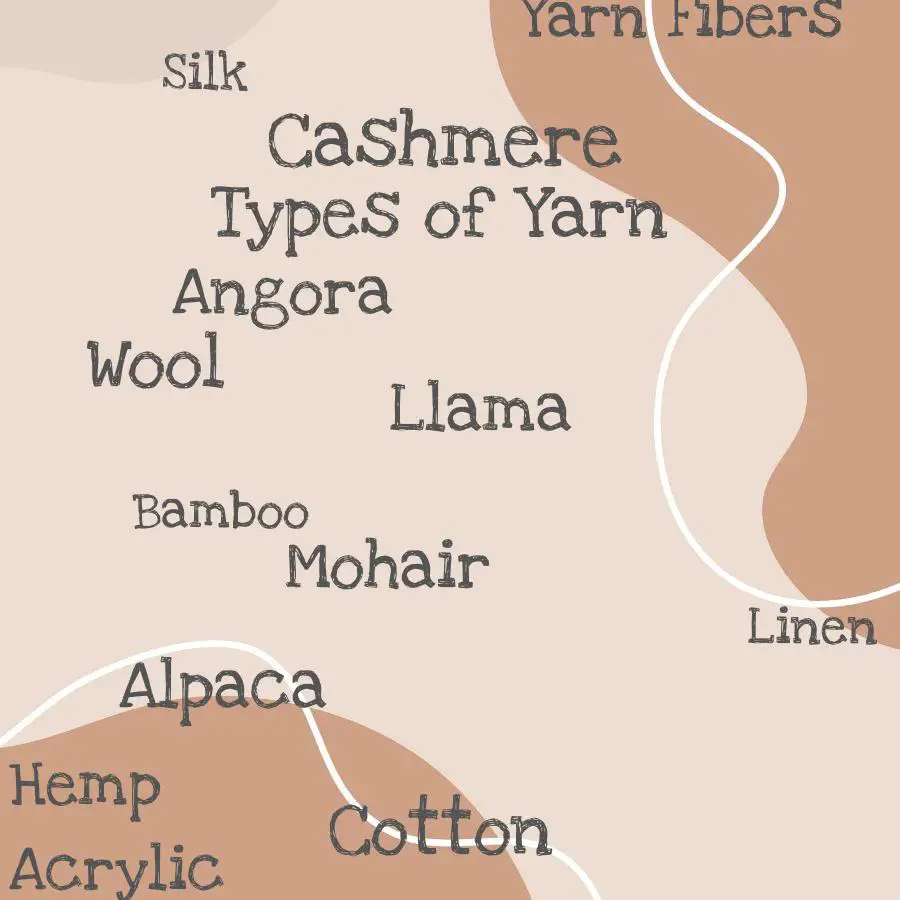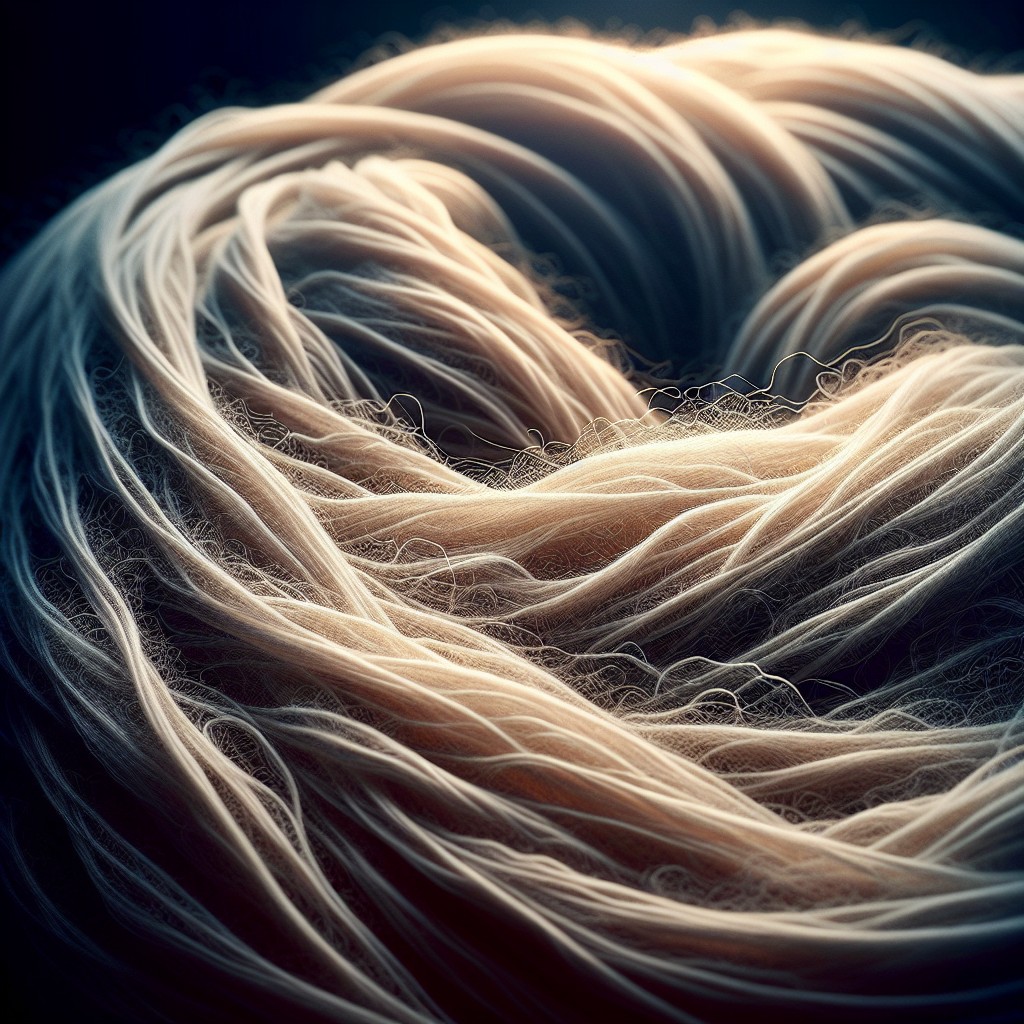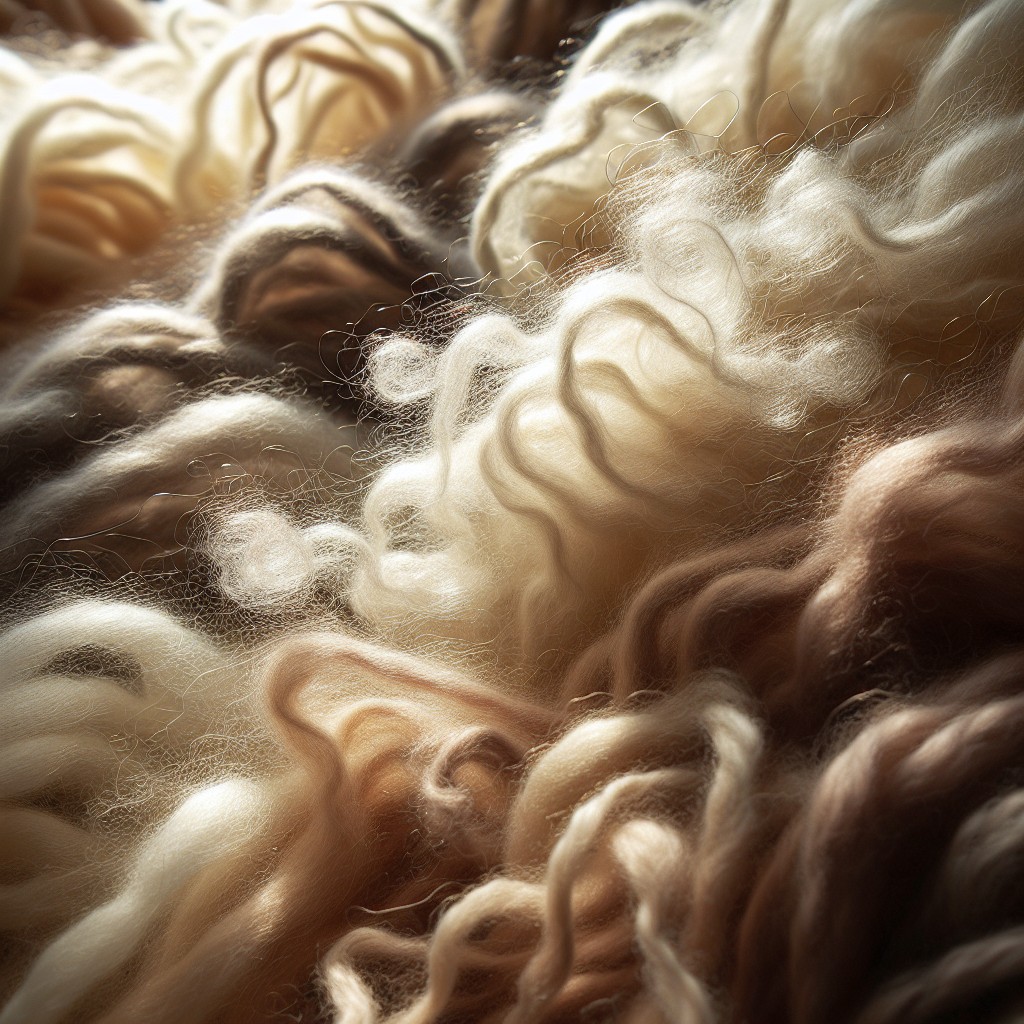Discover the fascinating world of yarn fibers, as we unravel various types and their unique characteristics perfect for all your crafting needs.
Are you a yarn enthusiast? Do you love to crochet or knit, but are confused about the different types of yarn fibers available in the market? Well, fear not! In this blog post, we will explore the various types of yarn fibers and their unique characteristics. From soft and fluffy alpaca to durable and versatile cotton, we will cover it all.
So grab your favorite cup of tea and let’s dive into the world of yarn fibers!
Wool

Wool is one of the most popular yarn fibers used by crafters worldwide. It comes from the fleece of sheep and has been used for centuries to create warm clothing, blankets, and accessories.
Wool is known for its natural insulation properties that keep you warm even in cold weather conditions.
There are different types of wool available in the market, each with unique characteristics. Merino wool is soft and fine, making it perfect for next-to-skin wearables like scarves or hats.
Shetland wool has a rustic texture that adds character to any project it’s used on.
One thing to note about using wool yarns is their tendency to felt when washed or agitated too much during use or cleaning; this can be an advantage if you want your finished product more durable but not so great if you’re looking for stitch definition.
Alpaca

It’s known for its softness, warmth, and hypoallergenic properties. Alpaca yarn is available in different grades depending on the fineness of the fibers.
The finer grade alpacas produce softer and more expensive yarns.
One of the unique characteristics of alpaca fiber is its ability to insulate even when wet, making it perfect for winter wearables like hats, scarves or mittens. It has a natural sheen that gives finished projects an elegant look.
When working with alpaca yarns be aware that they can stretch out over time due to their weight so consider using smaller needles or hooks than recommended by your pattern instructions.
Cashmere

It’s known for its warmth, lightweight feel, and durability. Cashmere fibers are finer than wool fibers, which makes them softer to the touch.
One of the unique characteristics of cashmere is its insulating properties. The fine hairs trap air between them, creating an excellent barrier against cold temperatures while still allowing your skin to breathe.
Cashmere yarn can be used in various projects such as scarves, shawls or sweaters due to its versatility and softness. However it’s important to note that this type of yarn requires special care when washing or handling it because it can easily become damaged if not treated properly.
Mohair

It’s known for its softness, luster, and durability. Mohair fibers are lightweight and have excellent insulating properties, making them perfect for winter garments like sweaters and scarves.
One of the unique characteristics of mohair is its ability to take dye exceptionally well. This means that you can find mohair in a wide range of colors to suit your project needs.
However, it’s essential to note that mohair can be challenging to work with due to its slippery texture. It tends not to hold shape as well as other yarn fibers like wool or cotton; therefore, it may require some extra care when knitting or crocheting.
Despite this challenge, many crafters love working with mohair because it creates beautiful finished products with an elegant drape and sheen.
Angora

It’s known for its softness, warmth, and fluffiness. The fibers are very fine and delicate, making it perfect for lightweight garments such as shawls or scarves.
One thing to note about angora is that it can shed quite a bit during knitting or crocheting. This shedding can be minimized by using sharp needles or hooks and working with the yarn in small sections at a time.
Another important consideration when working with angora is that some people may have allergies to rabbit hair. If you’re unsure whether you’re allergic to angora, try rubbing some on your skin before starting your project.
Llama
Llama wool is hypoallergenic, making it an excellent option for those with sensitive skin. It’s also lightweight and breathable, perfect for creating cozy garments that can be worn all year round.
One of the unique characteristics of llama fiber is its natural water resistance. This means that items made from llama wool will keep you warm even when wet, making it ideal for outdoor activities like hiking or camping.
When working with llama yarn, it’s important to note that it has a tendency to stretch out over time. To prevent this from happening in your finished project, consider using smaller needles or hooks than what the pattern calls for.
Cotton
It’s a natural plant-based fiber that comes from cotton plants, and it’s known for its softness, breathability, and durability. Cotton yarns are perfect for making lightweight garments such as summer tops or baby clothes because they’re comfortable to wear against the skin.
One of the best things about cotton yarns is their versatility. They come in different weights ranging from lace weight to bulky weight, which makes them suitable for various projects such as dishcloths, blankets or even home decor items like coasters.
Another advantage of using cotton yarns is their easy care instructions; they can be machine washed and dried without losing shape or color intensity.
However, one thing to keep in mind when working with 100% cotton fibers is that they tend to stretch out over time due to their lack of elasticity compared with other types of fibers like wool blends. Therefore it’s essential always to check your gauge before starting any project using this type of material.
Silk
It is made from the cocoon of the silkworm, which spins a fine thread to protect itself during metamorphosis. Silk yarns are known for their lustrous sheen, softness, and drape.
They come in various weights and textures suitable for different projects such as shawls, scarves, blouses or dresses.
One of the most significant advantages of silk yarns is their ability to absorb moisture while remaining cool against your skin making it perfect for summer garments or accessories. However,silk can be expensive compared to other fibers due to its labor-intensive production process.
If you’re looking into using silk in your next project but don’t want to break the bank on 100% pure silk yarns there are many blends available with wool,cotton,bamboo,and even synthetic fibers like nylon that offer similar characteristics at more affordable prices.
Linen
It’s known for its strength, durability, and ability to keep you cool in hot weather. Linen yarn has a unique texture that gives it an earthy feel and makes it perfect for summer garments like tops, dresses, and skirts.
One of the benefits of linen yarn is its absorbency; it can hold up to 20% moisture before feeling damp or wet. This feature makes linen ideal for towels or dishcloths as they dry quickly between uses.
Another advantage of using linen yarn is its hypoallergenic properties; this means that people with sensitive skin can wear clothes made from this material without any irritation.
When working with linen yarns, keep in mind that they tend to be stiffer than other fibers such as cotton or wool but soften over time after washing and wearing them several times. Also note that due to their natural texture, stitches may not appear as defined compared to smoother fibers like silk or acrylic.
Bamboo
It’s an eco-friendly option as bamboo grows quickly and requires less water than cotton. Bamboo yarn is soft, lightweight, and breathable making it perfect for summer garments or baby items.
It also has natural antibacterial properties that make it ideal for socks or other items that need to stay fresh longer.
One thing to keep in mind when working with bamboo yarn is its lack of elasticity compared to wool or acrylic fibers. This means you may need larger needles/hooks than usual and should avoid tight stitches if you want your project to drape well.
Hemp
It’s an eco-friendly option as it requires less water and pesticides than cotton, making it a sustainable choice for those who are environmentally conscious. Hemp yarn is strong, durable, and resistant to mold and mildew.
It also has antibacterial properties which make it ideal for items like dishcloths or towels.
Hemp yarn can be blended with other fibers such as cotton or silk to create unique textures in your projects. The resulting fabric will have a slightly rough texture but softens over time with use.
When working with hemp yarn, keep in mind that it does not have much elasticity compared to other fibers like wool or acrylics. This means you may need larger needles/hooks when crocheting/knitting so the finished product doesn’t end up too stiff.
Acrylic
It’s made from synthetic fibers, which means it’s easy to care for and can be machine washed without losing its shape or color. Acrylic yarn comes in a wide range of colors, making it perfect for creating vibrant projects such as blankets, scarves, hats, and more.
One of the benefits of acrylic yarn is that it doesn’t shrink or stretch like natural fibers do. This makes it an excellent choice if you’re looking to create items that need to maintain their shape over time.
Acrylic yarn tends not to pill as much as other types of fiber blends.
However, one downside is that acrylic isn’t very breathable compared with natural fibers like cotton or wool; this means garments made from 100% acrylic may not be suitable for warmer climates.
Polyester
It’s a man-made material that is created from plastic fibers, making it durable and long-lasting. Polyester yarns are often used for projects such as blankets, scarves, and hats because of their ability to hold up well over time.
One of the benefits of using polyester yarns is their affordability compared to natural fibers like wool or silk. They’re also easy to care for since they can be machine washed and dried without losing shape or color.
However, some people may find polyester yarns less comfortable than natural fibers due to its lack of breathability which can make it feel hot during warmer months.
Rayon
It has a soft and silky texture, making it perfect for creating lightweight garments such as summer dresses and blouses. Rayon can also be blended with other fibers to create unique textures and colors.
One thing to keep in mind when working with rayon yarn is that it tends to stretch out easily when wet. Therefore, it’s important to handle the finished garment gently during washing and drying.
Rayon offers an affordable alternative for those who want the look of silk without breaking the bank. Its versatility makes it an excellent choice for both beginner and experienced crafters alike!
Nylon
It quickly became popular due to its durability, strength, and elasticity. Nylon yarn is perfect for creating items that require stretch such as socks or sportswear.
It’s also great for making bags and other accessories because of its resistance to abrasion.
One of the benefits of nylon yarn is that it can be blended with other fibers like wool or cotton to add strength and durability without sacrificing softness or comfort. However, nylon does have some downsides; it’s not very breathable which means it may not be suitable for warmer climates.
When working with nylon yarn, keep in mind that it has a tendency to slip off needles easily due to its smooth texture so you may need sharper needles than usual when knitting with this type of fiber.
Yarn Fiber Blends
The resulting blend combines the best qualities of each fiber, creating a unique texture and appearance. For example, wool blended with silk creates a soft and lustrous yarn that is perfect for shawls or scarves.
Common blends include wool/acrylic, cotton/polyester, and alpaca/silk. These blends offer the benefits of both fibers while minimizing their drawbacks.
When choosing a blended yarn for your project, consider how you want it to feel against your skin as well as its durability and washability. Some blends may require special care when washing or blocking to maintain their shape.
Novelty and Specialty Yarn Types
These types of yarn come in a wide range of textures, colors, and materials that can make any project stand out. Some popular novelty yarns include eyelash yarn (which has long strands that resemble eyelashes), ribbon or ladder yarn (with thin strips woven into it), boucle (a looped texture) and chenille (soft with a velvety feel).
Specialty Yarn Types are also available for specific projects such as baby blankets or dishcloths. For example, cotton is an excellent choice for dishcloths because it’s absorbent and durable while bamboo is perfect for baby blankets due to its softness.
When working with these specialty fibers be sure to read the label carefully as they may require special care instructions when washing or blocking.
How to Choose a Yarn Type for Your Project
First and foremost, think about what type of item you want to create. Is it a cozy sweater or a delicate lace shawl? The pattern you choose will often dictate the type of yarn that is best suited for your project.
Next, consider the fiber content of the yarn. Different fibers have different properties that make them better suited for certain projects than others.
For example, wool is warm and durable but can be scratchy on sensitive skin while cotton is soft and breathable but lacks elasticity.
Another factor to keep in mind when selecting yarn is its weight or thickness. Yarns come in various weights ranging from super fine (lace) to super bulky (jumbo).
Choosing the right weight will affect how quickly your project progresses as well as its overall look and feel.
Lastly, don’t forget about color! While this may seem like an afterthought compared with other factors such as fiber content or weight; color can play an important role in bringing out texture patterns within knitting/crochet designs.
Yarn Type Comparison Chart
One of the most important is the type of fiber used in the yarn. Each fiber has its unique characteristics that affect how a finished project will look and feel.
To help you make an informed decision, we have created a Yarn Type Comparison Chart that lists various types of fibers and their properties such as texture, weight, durability, warmth level and more. This chart can be especially helpful when substituting one type of yarn for another or when trying out new patterns.
Best Knitting Yarn for Allergies and Sensitive Skin
Luckily, there are many options available that won’t cause irritation or discomfort. One of the best choices for those with allergies is bamboo yarn.
It’s naturally hypoallergenic and has antibacterial properties that make it resistant to odors and mildew.
Another great option is cotton yarn, which is soft and breathable but also durable enough to withstand frequent washing without losing its shape or color. If you’re looking for something warmer than cotton but still gentle on your skin, consider alpaca wool – it’s softer than regular wool and doesn’t contain lanolin (a common allergen found in sheep’s wool).
When shopping for knitting yarns suitable for sensitive skin types always look out for labels indicating “hypoallergenic” “organic” “non-toxic dyes”, etc., as these will help guide your choice towards safer options.
Best Yarn Type for Beginners
You want something that’s easy to work with and forgiving if you make mistakes. Acrylic is a great option for beginners as it’s affordable, widely available, and comes in a variety of colors and textures.
It’s also machine washable which makes it perfect for baby blankets or other items that will need frequent washing.
Another good option is wool-blend yarns which are soft but still have some elasticity making them easier to handle than pure wool fibers. They come in different weights so you can choose one appropriate for your project.
When starting out with knitting or crocheting, avoid using novelty or specialty yarn types such as eyelash or boucle as they can be difficult to work with due to their texture.
Types of Yarn: Printable Summary
This handy guide provides an overview of each type and its unique characteristics, making it easier to choose the right yarn for your project. You can print it out and keep it with your crafting supplies or save it on your phone or tablet for easy access while shopping online or at a local store.
The printable summary includes information on animal fibers like wool, alpaca, cashmere, mohair, angora as well as plant-based options such as cotton and linen. It also covers synthetic fibers like acrylics and polyesters along with novelty specialty yarn types that add texture to any project.
Yarn Weight Categories & Conversion Explained
Yarn weight refers to the thickness of the yarn and can range from super fine (lace) to super bulky. Each category has its own recommended hook or needle size, making it easier for you as a crafter to choose which one will work best for your project.
It’s essential also that you understand how different countries categorize their yarn weights since they may use different terms or systems of measurement. For instance, in North America, we use a numbered system ranging from 0-7 with 0 being laceweight and 7 being jumbo/bulky; whereas in Europe and Australia/New Zealand they use names such as fingering/4ply/sport/DK/worsted/aran/chunky/jumbo.
Yarn Textures and Why They Matter
The texture of the yarn can affect how your finished product looks and feels. Some textures are better suited for certain projects than others.
For example, if you’re making a cozy blanket or scarf, you might want to choose a bulky or chunky textured yarn that will provide warmth and comfort. On the other hand, if you’re making delicate lacework or intricate patterns in crochet or knitting projects like doilies or shawls then finer textured threads would be more suitable.
The texture of the yarn also affects how easy it is to work with when crocheting/knitting as well as its durability over time. Smooth-textured fibers such as silk tend to slip off needles easily while rougher textures like wool may require more effort but offer greater grip on needles/hooks which makes them ideal for beginners who need extra control.
Animal Fibers
These natural fibers come from animals such as sheep, alpaca, cashmere goats, mohair goats, angora rabbits or llamas. They are known for their warmth and softness which make them perfect for cozy winter garments like sweaters or scarves.
Wool is one of the most common animal fiber types used in yarn production. It comes from sheep’s fleece and can be found in various textures ranging from fine to coarse depending on the breed of sheep it came from.
Alpaca fiber is another popular choice among knitters due to its luxurious feel that rivals cashmere but at a more affordable price point. Alpacas produce a hypoallergenic wool that makes it ideal for people with sensitive skin.
Cashmere comes from Cashmere goats’ undercoat hair which gives this type of wool its signature softness while also being lightweight yet warm enough to keep you comfortable during colder months.
Mohair is produced by Angora goats’ long silky hair strands making it durable yet delicate at the same time giving your projects an elegant touch. Angora rabbit fur produces fluffy yarns with halo-like effects adding texture and dimensionality when incorporated into any project.
Llama wool has similar properties as alpaca but tends to have longer hairs resulting in stronger threads suitable for heavier garments like blankets or coats.
Plant Fibers
These fibers come from various plants such as cotton, linen, bamboo, and hemp. Cotton is the most commonly used plant fiber in yarn production due to its softness and versatility.
It’s perfect for making lightweight garments like summer tops or baby blankets.
Linen is another popular plant fiber that has been used for thousands of years due to its durability and strength. It’s ideal for creating items that require structure like bags or home decor pieces.
Bamboo yarn has gained popularity in recent years because it’s incredibly soft with a luxurious feel similar to silk but at an affordable price point. This type of yarn is also hypoallergenic which makes it perfect for people with sensitive skin.
Hemp yarn may not be as well-known as other plant-based options but it offers excellent durability while being environmentally friendly since hemp requires less water than cotton during cultivation.
Synthetic Fibers
These fibers are made from man-made materials such as polyester, nylon, and acrylic. They offer a wide range of benefits that natural fibers cannot provide.
One significant advantage is their durability; they can withstand wear and tear better than most natural fiber types. Synthetic yarns are often more affordable than their natural counterparts.
Another benefit is that they come in an extensive range of colors and textures which makes them perfect for creating unique projects with vibrant hues or unusual textures.
However, some people may find these materials less comfortable to work with due to their lack of breathability compared to animal or plant-based options like cotton or wool. Also important to note is that synthetic yarns do not biodegrade easily making them less environmentally friendly compared to other types.
FAQ
What are the different types of yarn fibers?
Answer: The different types of yarn fibers include animal fibers (wool, cashmere, alpaca), plant fibers (cotton, linen, bamboo), and synthetic fibers (rayon, acrylic, nylon).
What is the strongest yarn?
The strongest yarn is nylon due to its incredible durability and elasticity.
What are three different types of yarn?
Three different types of yarn include wool, acrylic, and cotton.
What are the characteristics of different yarn fibers?
Yarn fibers characteristics: wool is warm and elastic, cotton is soft and breathable, silk is smooth and lustrous, synthetic fibers are durable and water-resistant, and linen is lightweight and absorbent.
How to select the appropriate yarn fiber for a specific project?
To select the appropriate yarn fiber for a specific project, consider the desired texture, durability, and care requirements while keeping in mind the project’s purpose and the preferences of the user.
What is the environmental impact of various yarn fibers?
Environmental impact of various yarn fibers: Cotton production requires large amounts of water and pesticides, synthetic fibers generate microplastic pollution, and wool can lead to overgrazing and land degradation.
